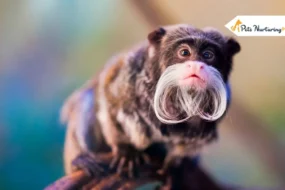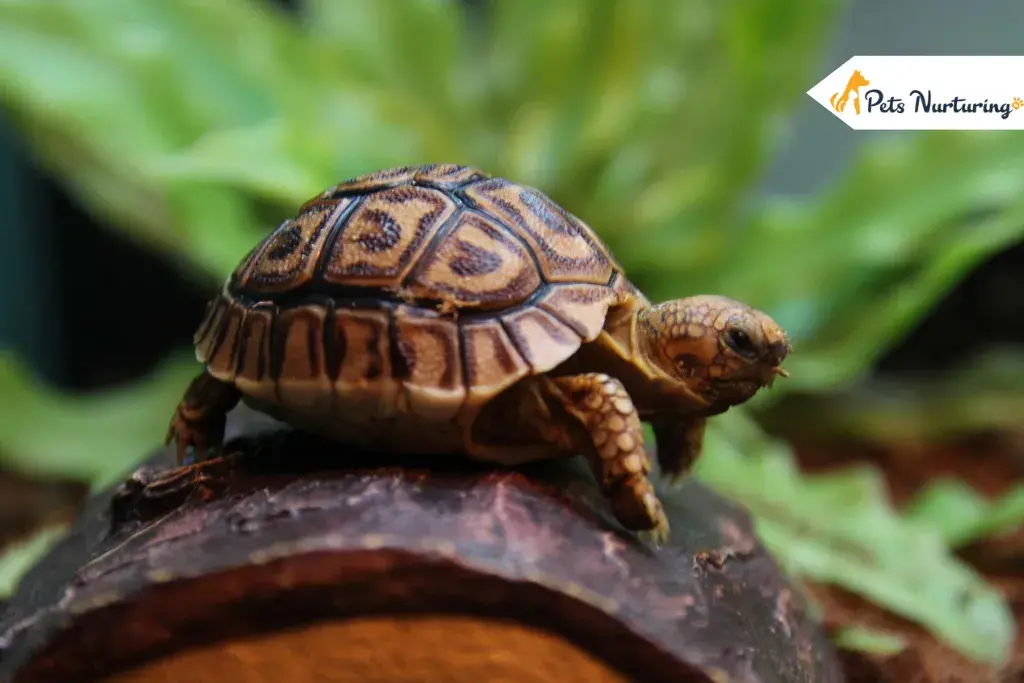
Pet tortoises have become very common and a popular choice as pets as they are easy to care for and do not require much of our time, attention, and involvement when compared to other pet animals like cats, dogs, or a pet iguana. Although they are fun and pretty easy to care for, tortoises are not an ideal choice to keep as pets. Even when you do own a pet tortoise, you need to understand that they don’t want to be cuddled, played with, or want you as involved as you’d be with a dog or cat. Pet tortoises aren’t comfortable with too much handling.
A common mistake that people make when it comes to a tortoise is that they confuse them for a turtle. A turtle and a tortoise are NOT THE SAME. They are two different beings. Tortoises are not the same as turtles because all tortoises can scientifically be called turtles, but all turtles are not tortoises.
Let me simplify it for you. Turtle is the word used for species of the order Testudines which simply means, reptiles having bodies that are encased in a bony shell so technically since the tortoise falls under this criterion you can call it a type of turtle.
BUT not all turtles can be referred to as tortoises as the word tortoise is used to refer to the specific type that lives on land. To avoid ALL this confusion, it’s better to use the word ‘turtle’ for the water dwellers only and ‘tortoise’ for those that live their life on land.
Differentiate Tortoise And Turtle
Let’s begin our pet tortoise guide by helping you understand how you can differentiate the two species that are commonly confused for one another.
| Tortoise | Turtle |
|---|---|
| Tortoises are land-dwelling. | Turtles live mainly in water. |
| They do not have webbed feet. | They have webbed feet. |
| Shells are mostly dome-shaped. | They have flat and streamlined shells. |
| Tortoises have short and study feet. | Turtles have long claws. |
| Have a longer lifespan- 50 to 100 years or even more | They live for 20 to 40 years. |
| Herbivore in nature. | They are omnivores. |
Another important thing to consider before getting a tortoise is its lifespan. Tortoises can live for a very long time, they may, in fact, outlive you so you have to be prepared for lifelong care and commitment. The oldest tortoise in the world is known to have lived up to the age of 189.
There are various species of tortoises, each one different from the other. You can find the best pet tortoise for you as you learn about the various types of pet tortoises in our pet tortoise guide.
Tortoise belongs to the reptile species. There are many types of pet tortoises or pet tortoise breeds. Pet tortoise species are species of order Testudines just like the turtles with the major difference being, they are non-swimmers and mainly live on land as I mentioned above.
The pet tortoise species or any tortoise, in general, belongs to class Reptilia meaning they are reptiles, which are cold-blooded and grow up to 10 inches long. We will learn more about tortoise care and management before we look into types of tortoises as pets.
Pet Tortoise Care
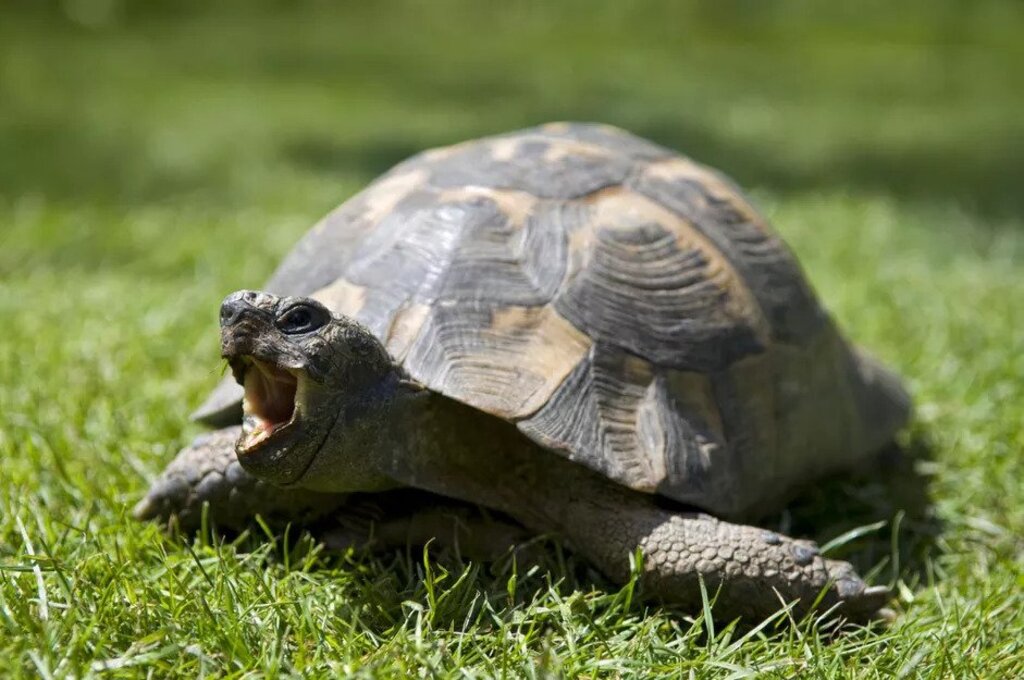
1. Housing
Pet tortoise care is a simple process and the first thing to know is they need a big enough space or enclosure to roam around for them to thrive. There are various types of tortoises from various parts of the world and they thrive better in housing that provides them with conditions resembling their place of origin.
A fully grown pet tortoise needs 4 square feet of area or an enclosure of 8 cubic feet which is well ventilated and lit. Medium-sized or larger ones may require more area. They prefer living outdoors and in areas that do not experience extreme climatic conditions.
2. Tank or Enclosure Setting
Decorate the enclosure with sticks and lots of plants as anything vegetarian won’t be harmful to them to chomp on as they are herbivores. Provide slip-proof bedding made of soil, bark, or coconut fiber. Make sure to keep the area clean and change the bedding completely at least once a month.
If they are living outdoors make sure you use strong fences and bury them deep in the soil if you have a burrowing species of pet tortoise. Tortoises are good climbers so you either have to have high fences outdoors or a roof to cover the enclosure. Always provide a shelter or a hiding spot.
Do not keep any poisonous plants or harmful, sharp, or tiny edible objects in the pen that may prove to be hazardous.
3. Temperature
Tortoises are cold-blooded and cannot adjust their body temperature according to the environment, you might have to bring the outdoors ones, in, during cold weather which is challenging if you own a big breed. Optimal temperature range for them is 70 to 90 degrees Fahrenheit.
Many tortoises prefer going into hibernation during certain seasons which is not possible when you have them as pets, this can be particularly stressful for them. To decrease the chances of this, keep their living area damp and warm which may vary from species to species.
Place a high watt heat bulb on one side of the enclosure to make it comparatively warmer so that your tortoise can choose to stay on the warmer or the cooler side depending on its need. You can put a thermometer on both ends of their enclosure to keep track of the temperature.
Another important thing is to provide shade or a hiding area as they prefer to be alone and hidden at times. During the night to provide the heat you can use ceramic heat emitters as they need a balance of daylight and darkness.
Apart from heat, they require UV light to synthesize vitamin D3 which is needed to metabolize calcium and prevent metabolic bone disease. If you have them indoors, make sure you provide them with UV light 12 hours a day using a UVB bulb
4. Temperament and Behavior
Tortoises are of shy and docile nature. We advise against keeping two males together as they can get aggressive which may result in a fight leading to serious injuries.
Do not try to handle them too much when there isn’t a need, especially when it comes to larger varieties as it can lead to stress which makes them prone to illness. Let them adapt to the new living space when you bring them home and try not to handle them in the initial week.
5. Diet of a Pet Tortoise
Their diet should comprise 85% vegetables, 5% protein and 10% fruits. Earthworms, mealworms, etc can be used as sources of protein. Protein is important but make sure you aren’t overfeeding them protein as it has its own drawbacks. Some omnivore species enjoy animal-source protein.
Pet tortoises enjoy diverse and brightly coloured fruits and vegetables in their diet. Dark and leafy vegetables like kale, mustard greens, and collards are extremely healthy for them. Grass hay can also be added to increase fiber content.
Calcium and other powdered supplements must be added to each meal to make a balanced diet. Provide fresh water and food daily although some adult tortoises may prefer to eat on alternate days.
Common Medical Conditions
- Burns (heat lamps)
- Metabolic bone disease
- Parasites
- Pneumonia
- Retained eggs
- Swollen eyelids
- Trauma (vehicle, predator)
- Upper respiratory tract disease
Common signs of illness : If you notice any of these, it’s advised to male a quick visit to your vet.
- More time spent hiding in the shell
- Loss of appetite
- Weight loss
- Swollen joints
- Discharge from the eyes, nose, or mouth
- Shell problems like discoloration or softening of the shell
- Droppings that are runny for more than two days
- Wheezing
- Gasping/open mouth breathing
Now that we have learned all about the care and management let’s dive into the pet tortoise guide to learn about the best pet tortoise breeds:
1. Greek Tortoise
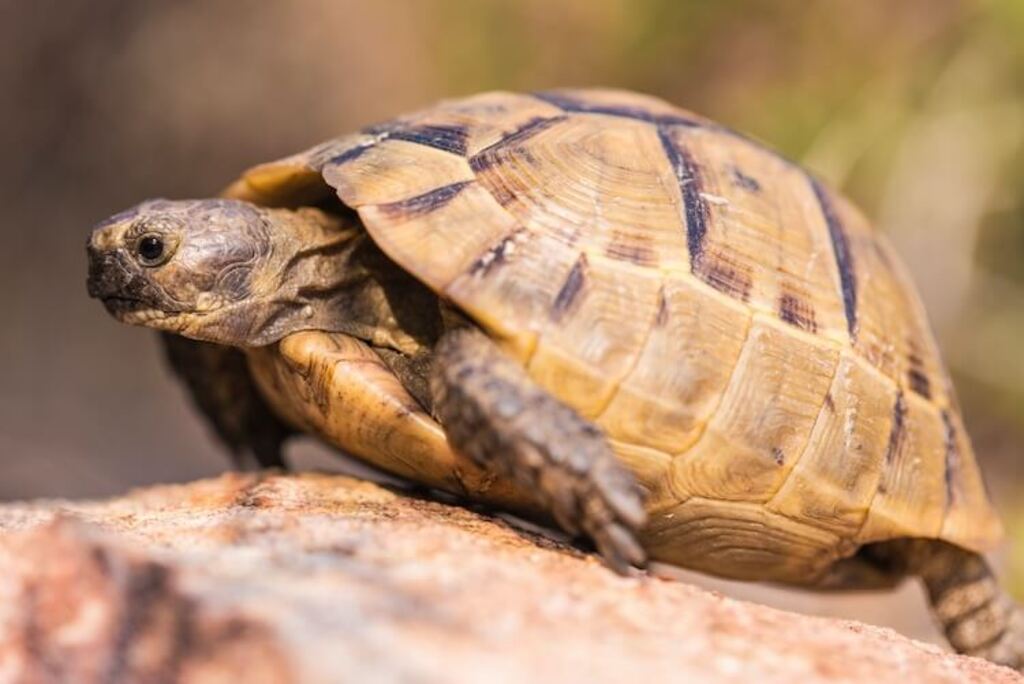
Widespread throughout the Mediterranean and the middle east, they are one of the most popular species of pet tortoise.
Their shell is dome-shaped with golden to black colour patterns with spurs on either side of their tail giving them the name, the Mediterranean spur-thighed tortoise.
| Size | up to 10 inches long |
| Lifespan | 125+ years in the wild |
| Humidity requirement | 40-60% |
| Temperature | 75 to 90 degrees Fahrenheit |
| Space requirement | 18 sq.ft |
2. Russian Tortoise
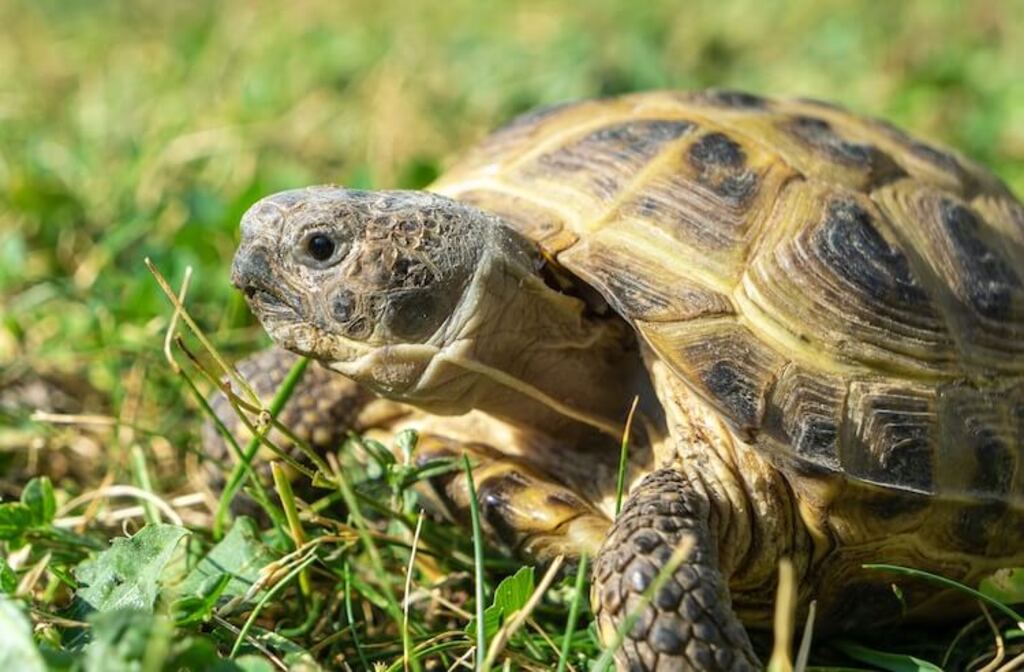
Found in the southeast to middle east Russia.
They are burrowers and may dig around the fence, thus strong fencing is required.
They are easy to care for as they easily adapt to different temperatures.
| Size | 8-10 inches long |
| Lifespan | 40+ years |
| Humidity requirement | 30-50% |
| Temperature | 60 to 90 degrees Fahrenheit |
| Space requirement | 18 sq.ft |
3. Sulcata Tortoise
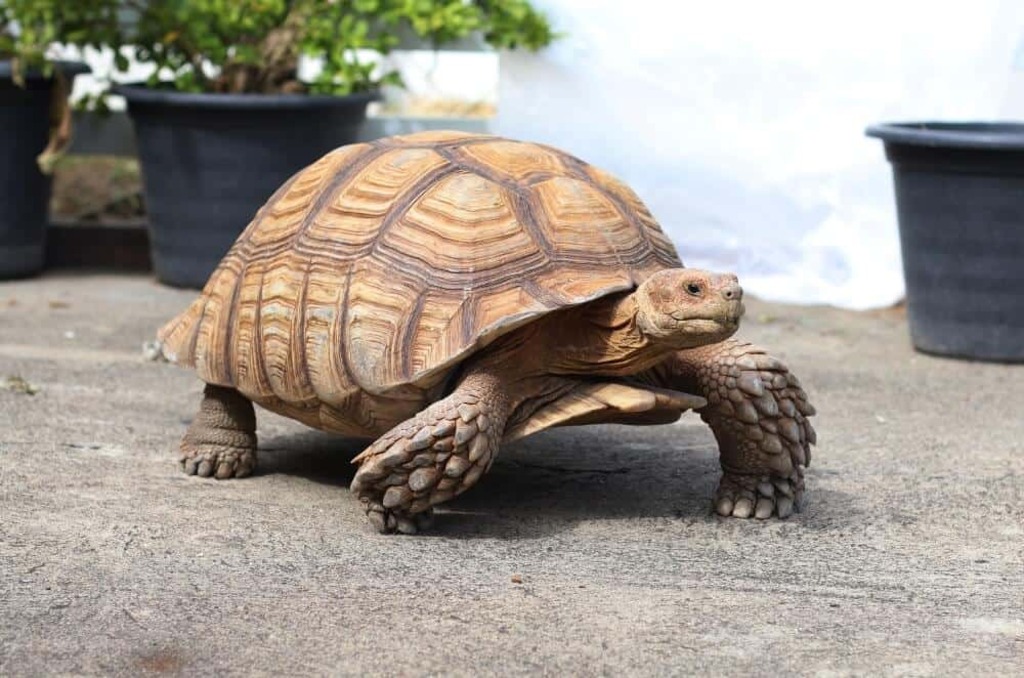
One of the largest types of tortoise species in the world and are found in the Sahara desert.
They love to dig and burrow
They like eating lettuce, grasses and leaves.
Outdoor tortoise with a need for a lot of space.
They are intelligent and love human interaction.
| Size | up to 30 inches long |
| Lifespan | 50 years |
| Humidity requirement | 40-60% |
| Temperature | 75 to 90 degrees Fahrenheit |
| Space requirement | 80 sq.ft |
4. Indian Star Tortoise
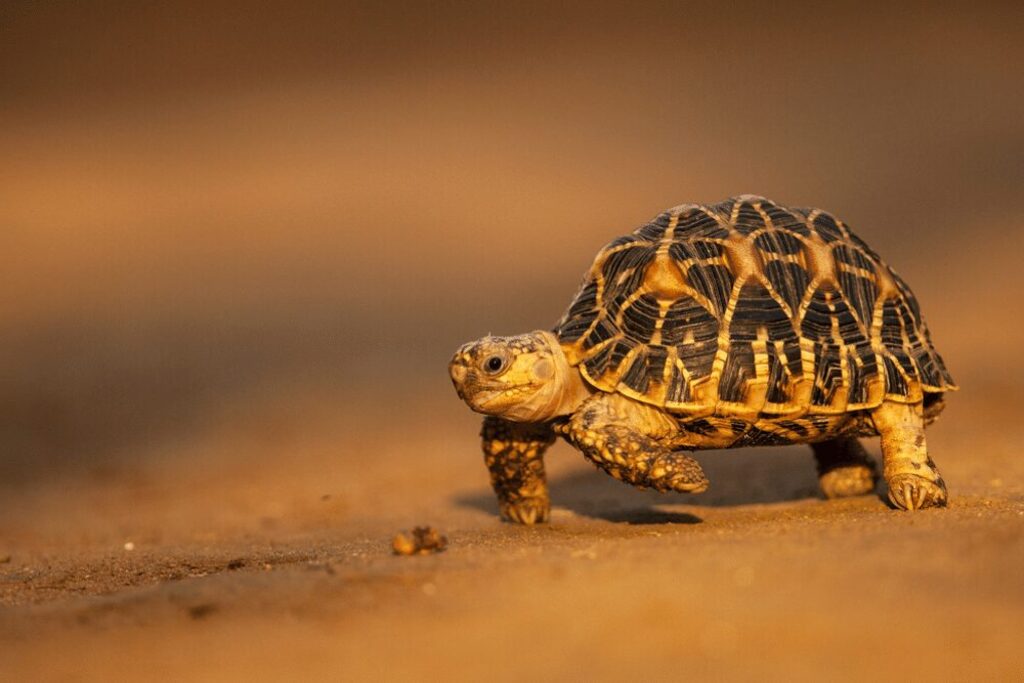
This pet tortoise breed is found throughout India and Sri Lanka and is famous for the star-like pattern on their shell.
They are threatened in their native and hence are now illegal for export.
They are one of the most expensive breeds of tortoise.
Sociable in nature.
| Size | up to 12 inches long |
| Lifespan | 35 years |
| Humidity requirement | adapt to varying humidity levels |
| Temperature | 75 to 90 degrees Fahrenheit |
| Space requirement | 36 sq.ft |
5. Hermann’s Tortoise

Native of the Mediterranean basin.
It is among the smaller types of tortoises.
They are known for their single horn-like claw found at the tip of their tail.
Prefer warm outdoors and need high fencing as they love to climb.
Docile and gentle in nature.
Have a great temperament and hence, good for beginners.
| Size | up to 8 inches long |
| Lifespan | 75+ years |
| Humidity requirement | 60% |
| Temperature | 70 to 80 degrees Fahrenheit |
| Space requirement | 16 sq.ft |
6. Red-footed Tortoise
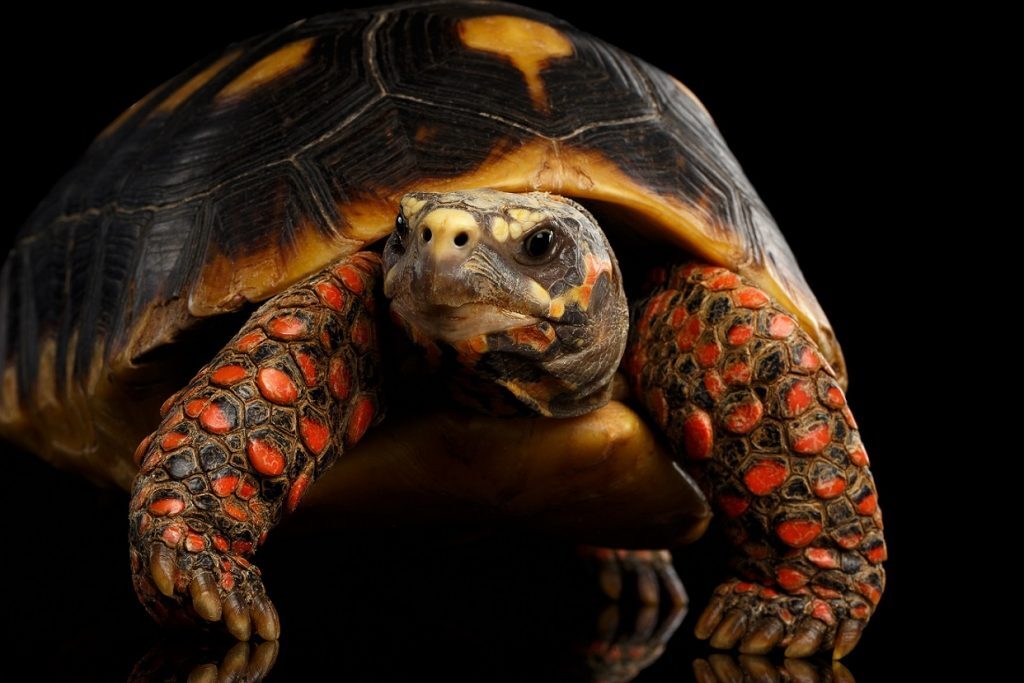
Native to south america and caribbean islands.
They have red legs which gives them their name.
They can even have a red tail and red head, hence they are also known as cherry heads.
These types of tortoises are curious in nature and easy to care for.
They are not entirely herbivorous, they eat small insects and mice.
| Size | up to 14 inches long |
| Lifespan | 45+ years |
| Humidity requirement | 70 to 80% |
| Temperature | 80 degrees Fahrenheit |
| Space requirement | 50 sq.ft |
7. Leopard Tortoise
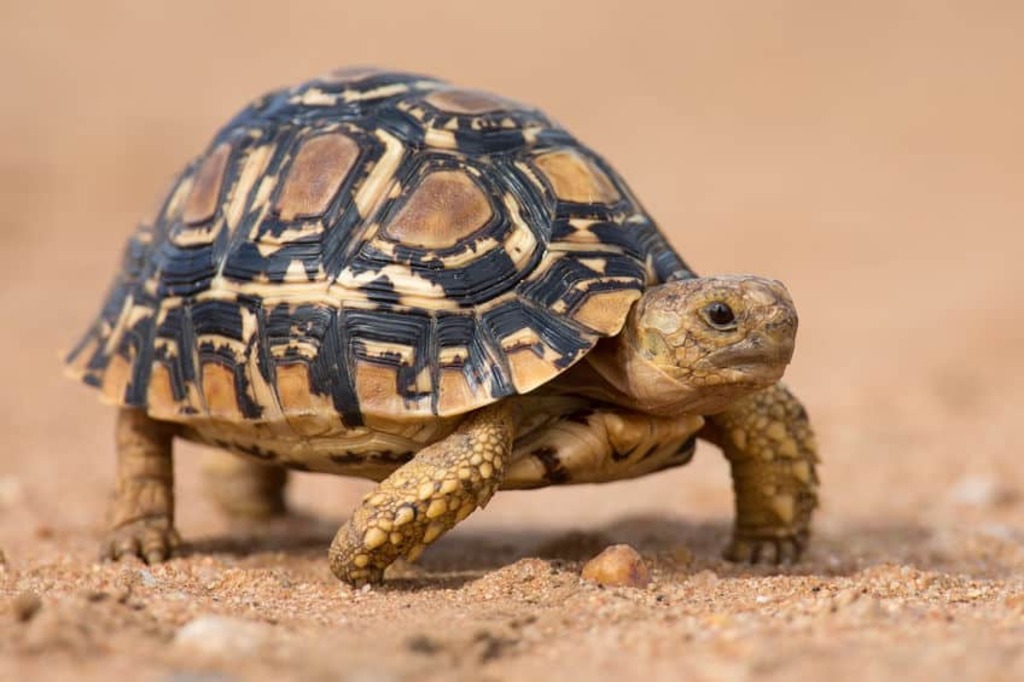
They are the second-largest species native to Africa and rank as 4th largest in the world.
They are usually in shades of black, yellow and brown with a unique blotchy pattern on their shell.
These types of tortoises are herbivores but prefer forbs like seeds, grains, and nuts over greens.
They have a calm temperament and are docile in nature.
They do not dig.
| Size | up to 17 inches long |
| Lifespan | 50+ years |
| Humidity requirement | do not tolerate moist conditions |
| Temperature | 80 to 90 degrees Fahrenheit |
| Space requirement | 80 sq.ft |
8. Pancake Tortoise

They are sub-saharan species.
Pancake tortoise is a breed of tortoise famous for it’s flat shell-like sea turtles.
They have high speed and flexibility.
They are good climbers for a tortoise.
These types tortoises are easy to care for.
| Size | up to 7 inches long |
| Lifespan | 30 years |
| Humidity requirement | 60 to 75% |
| Temperature | 70 to 75 degrees Fahrenheit |
| Space requirement | 4 sq.ft |
It is important to choose the right species of pet tortoise for you depending on their housing needs, environmental needs, and dietary requirements. Different species have different sizes, temperature needs, light requirements, and diets. Whereas some need to hibernate while others do not.
Being well researched before getting a pet tortoise will make both of your lives easier and better. Adopting a species with a lifespan this long is a big commitment so if there’s any chance that you won’t be able to care for them, you must consider pets with a shorter life span. You can also see yellow belly turtle.
Find out more :











